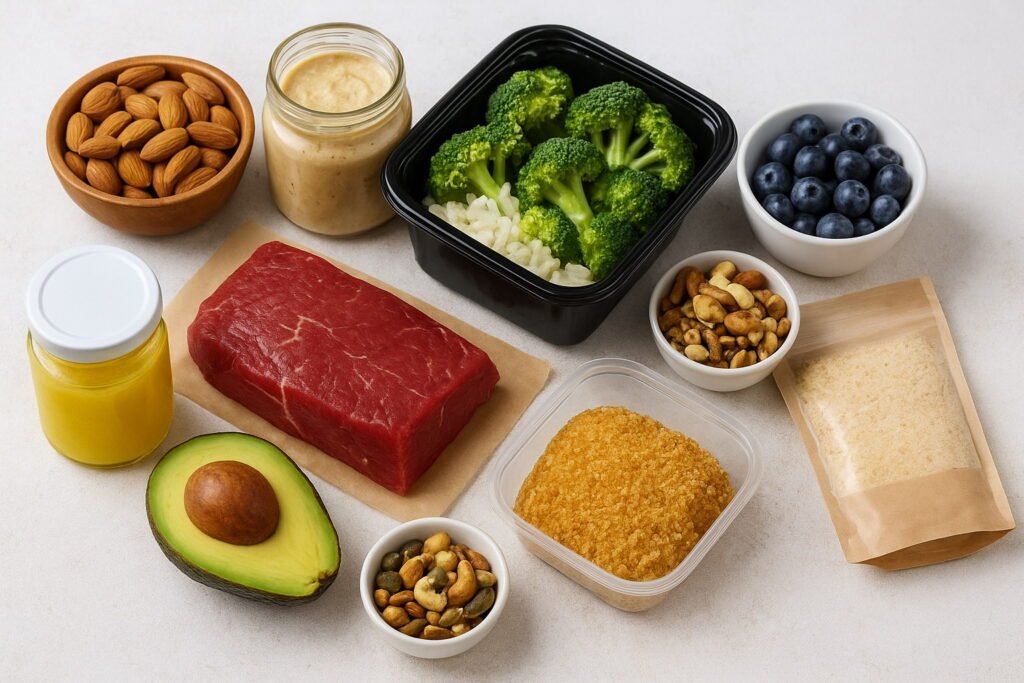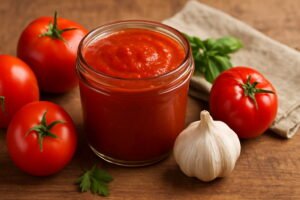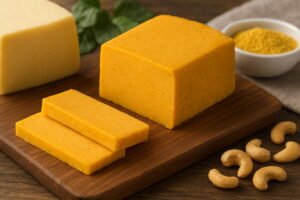The world of Paleo friendly food products 2025 is evolving faster than ever, driven by cleaner labels, smarter ingredient sourcing, and a renewed focus on nutrient-dense eating. More people are turning to Paleo as a sustainable lifestyle rather than a short-lived diet, and brands in 2025 are responding with innovative foods that support energy, digestion, and overall wellness.
This article explores the new wave of products shaping the Paleo landscape and highlights the trends that make 2025 a standout year for health-forward eaters. Whether you’re building a pantry from scratch or looking to upgrade your favorites, these insights will help you choose better, smarter, and more aligned Paleo options.
In This Article
What Makes a Product Paleo Friendly?
Understanding what qualifies as Paleo is essential before exploring the top Paleo friendly food products 2025. The Paleo philosophy centers on eating the way early humans did—prioritizing whole, unprocessed foods and leaving behind modern, highly refined ingredients.
Core Paleo Principles
Paleo-approved foods include:
- Grass-fed and pasture-raised proteins
- Wild-caught seafood
- Vegetables, fruits, roots, and tubers
- Healthy fats such as avocado oil, coconut oil, and tallow
- Nuts, seeds, herbs, and spices
Foods excluded on Paleo:
- All grains (including oats, rice, corn, and wheat)
- Legumes (soy, beans, peanuts)
- Refined sugars and artificial sweeteners
- Dairy (except occasional grass-fed ghee for some individuals)
- Industrial seed oils (canola, soybean, safflower)
- Additives, gums, preservatives, and lab-made flavors
Quick Paleo Evaluation Formula
A simple three-step test helps determine whether an item truly qualifies as Paleo-friendly:
| Step | What to Check | Why It Matters |
| 1. Ingredient List | Look for whole, recognizable ingredients only. | Minimizes exposure to fillers and additives. |
| 2. Source Quality | Check for grass-fed, wild-caught, organic, or minimally processed indicators. | Helps ensure nutrient density and sustainability. |
| 3. Sweeteners & Oils | Confirm there are no refined sugars or seed oils. | Keeps inflammation low and aligns with Paleo principles. |
The 2025 Shift Toward Cleaner Products
Manufacturers in 2025 are increasingly avoiding:
- Carrageenan
- Maltodextrin
- Natural flavors
- Modified starches
- Hydrogenated oils
This shift has led to ingredient lists that are shorter, cleaner, and more transparent—exactly what Paleo followers appreciate.
A food scientist at a major health brand recently noted, “Consumers no longer accept vague terms. Simple labels and ethical sourcing are becoming the minimum standard, not an upgrade.” This mindset is the foundation of product innovation in 2025, setting the stage for smarter Paleo options.
Trends Shaping Paleo Friendly Food Products 2025
The Paleo market in 2025 is not only bigger but noticeably more thoughtful. New product lines cater to time-crunched families, athletes, and everyday health-conscious consumers seeking balanced nutrition without compromise.
Key Trends Dominating the Paleo Space
• Clean-label momentum
Brands are eliminating artificial additives, simplifying recipes, and highlighting every ingredient source.
• Functional nutrition focus
Ingredients like collagen peptides, bone broth concentrates, MCT oil, and adaptogens are appearing more frequently. These additions support joint health, metabolic efficiency, cognitive function, and gut resilience.
• More options for ready-to-eat Paleo meals
Frozen Paleo bowls, heat-and-serve entrées, and portable meal cups have become staples for busy shoppers who want convenience without sacrificing quality.
• Sustainability becoming a major purchasing factor
Regenerative agriculture, compostable packaging, and responsible fisheries now influence consumer decisions as much as flavor and price.
2025 at a Glance: Paleo Market Growth Facts
| Category | Growth Rate (2024–2025) | What’s Driving It |
| Paleo snacks | +18% | Rise of travel-friendly, whole-food options |
| Paleo protein products | +24% | Fitness culture + clean protein demand |
| Paleo baking items | +15% | Grain-free baking becoming mainstream |
| Ready-to-eat Paleo meals | +32% | Lifestyle convenience + health priorities |
Case Study: The Rise of Grain-Free Convenience Foods
A leading natural foods brand introduced a line of cassava-based frozen Paleo empanadas early in 2025. With just 7 whole-food ingredients and zero preservatives, the product sold out nationwide within weeks.
Key takeaway: Cleaner convenience foods are no longer niche—they’re shaping mainstream shopping habits.
Why These Trends Matter
These innovations make Paleo easier and more accessible. Whether you’re a long-time Paleo eater or just beginning your journey, Paleo friendly food products 2025 give you the flexibility to eat clean without spending hours in the kitchen.
Best Paleo Pantry Staples for 2025
A well-curated pantry makes Paleo living easier, especially with the growing variety of Paleo friendly food products 2025. This year introduces smarter, cleaner staples that simplify meal prep and support a nutrient-dense lifestyle.
Essential Nut & Seed Staples
These products form the backbone of many Paleo meals and snacks:
- Almond flour & coconut flour – top choices for grain-free baking.
- Mixed nut butters – now crafted without palm oil or stabilizers.
- Seed blends – pumpkin, chia, and sunflower seeds in single-ingredient packaging.
- Trail mixes – increasingly produced without refined sugar or seed oils.
2025 Update: Many brands are offering activated nuts and seeds, which are soaked to improve digestibility and reduce phytic acid.
Healthy Fats for Cooking
High-quality cooking fats remain central to Paleo nutrition:
- Grass-fed tallow
- Virgin coconut oil
- Avocado oil
- Duck fat
- Olive oil (cold-pressed)
These fats support stable energy, enhance nutrient absorption, and withstand high-heat cooking.
Paleo-Friendly Sweeteners
A wave of new minimally processed sweeteners hit the market in 2025:
| Approved Sweetener | Key Benefit | Notes |
| Raw honey | Antioxidants, natural enzymes | Avoid ultra-filtered versions |
| Maple syrup | Minerals + robust flavor | Best in small amounts |
| Date sugar | Fiber-rich | Great for baking |
| Coconut sugar | Low glycemic | Works well in sauces |
Shelf-Stable Snacks Worth Trying
- Dried fruit without sulfites
- Cassava chips fried in avocado oil
- Paleo jerky without soy or sugar
- Seaweed snacks with mineral-rich sea salt
- Fruit-sweetened energy bars
These staples make it simple to stay Paleo even during hectic days or travel.
Top Paleo Protein Products of 2025
Protein sources have seen some of the most exciting upgrades among Paleo friendly food products 2025. Clean, ethically sourced options continue to expand, offering versatility for snacks, meal prep, and post-workout nutrition.
Grass-Fed Beef & Jerky Innovations
A standout trend in 2025 is the return to extremely simple recipes:
- 100% grass-fed beef
- Sea salt
- Organic spices
- No nitrates, cane sugar, soy, or preservatives
Many brands now publish farm origin, processing methods, and lab test results—offering unprecedented transparency.
Pasture-Raised Poultry Protein Options
New chicken and turkey products include:
- Air-dried chicken strips
- Sugar-free turkey sticks
- Bone-in canned chicken in pure broth
- Freeze-dried diced chicken for emergency kits
These options make high-quality protein accessible and long-lasting.
Wild-Caught Seafood Choices in 2025
Seafood remains a key protein category due to its omega-3 content and bioavailability.
Popular options include:
- Wild sardines packed in olive oil
- Salmon jerky with clean, minimal seasoning
- Canned mackerel, tuna, and anchovies
- Freeze-dried cod for camping or travel
A nutritionist recently said, “Wild-caught seafood remains one of the cleanest proteins available, especially when packed without industrial oils.”
Collagen Powders, Bone Broth & Protein Blends
Collagen continues to surge due to its benefits for joints, skin, and gut lining.
Key 2025 formulations:
- Collagen peptides sourced from pasture-raised bovine
- Marine collagen for pescatarians
- Bone broth concentrates with 10–15 g protein per serving
- Multi-source Paleo protein blends (beef + egg white + collagen)
Most products avoid gums, flavor additives, or sugar—keeping them aligned with Paleo values.
Paleo Baking & Cooking Essentials in 2025
Grain-free baking and scratch cooking have grown dramatically, leading to upgraded mixes, cleaner ingredients, and more nutrient-dense meal helpers. These advancements make it easier to prepare Paleo-friendly dishes at home.
Updated Grain-Free Flours
Brands have refined their milling processes to produce finer textures and better baking performance:
- Cassava flour – softer, more elastic results
- Coconut flour – lower moisture retention
- Almond flour – finer grind for breadlike texture
- Green banana flour – rich in resistant starch, supporting gut health
New Baking Mixes Without Gums or Fillers
Shoppers in 2025 prefer minimal ingredients. Many Paleo mixes now contain:
- Only 3–5 ingredients
- No xanthan gum
- No “natural flavors”
- Simple salt and herbs
- Arrowroot or tapioca as natural binders
These mixes help create muffins, breads, tortillas, and pancakes with a clean, homemade feel.
Cooking Sauces & Marinades Aligned with Paleo
Many everyday sauces now offer Paleo-friendly formulations:
- Tomato sauces sweetened with vegetables instead of sugar
- Coconut-amino marinades with ginger and garlic
- Mustards without wine, wheat, or sweeteners
- Clean barbecue sauce using dates for sweetness
Grain-Free Breading & Coatings
Innovative coatings are popular in 2025 for oven-fried Paleo dishes:
| Paleo Coating | Best Use | Benefit |
| Almond flour + paprika | Chicken tenders | Crispy crust |
| Cassava crumbs | Fish fillets | Grain-free breadcrumbs |
| Shredded coconut + spices | Shrimp | Sweet, crunchy layer |
| Pork rind crumbs (clean) | Vegetables | Extra protein & crunch |
These coatings allow for satisfying texture without grains, seed oils, or processed breadcrumbs
Paleo Friendly Snacks & Convenience Foods for 2025
Convenience is a major driving force behind many Paleo friendly food products 2025. With more people juggling work, parenting, and travel, brands are producing smarter grab-and-go options that maintain nutrient integrity without compromising on flavor or quality.
Ready-to-Eat Paleo Bowls & Frozen Meals
Frozen Paleo options have evolved far beyond simple vegetables and protein. In 2025, brands are introducing:
- Sweet potato and grass-fed beef bowls
- Cauliflower rice stir-fry with wild-caught shrimp
- Pulled pork with root vegetable medley
- Chicken curry made with coconut milk + clean spices
These meals are free from dairy, soy, grains, seed oils, and added sugars—making them ideal for fast, wholesome dinners.
Grain-Free Chips, Crackers & Crunchy Snacks
Crunchy snacks continue to rise in popularity. Standout 2025 offerings include:
- Cassava-based chips fried in avocado oil
- Grain-free crackers made from almond flour
- Beet and carrot chips baked without preservatives
- Plantain chips using only coconut oil + sea salt
These snacks have shorter ingredient lists and often contain 3–6 ingredients total, aligning with Paleo’s focus on simplicity.
Energy Bars & On-the-Go Treats
Bars and portable bites have seen a major clean-up this year:
Common characteristics of 2025 Paleo bars:
- Fruit-sweetened
- Nut and seed bases
- Zero added refined sugar
- Minimal oils and no synthetic binders
- Grass-fed collagen added for protein
Many brands are removing chocolate chips made with cane sugar, replacing them with 100% cacao or date-sweetened alternatives.
Travel-Friendly Products for Busy Lifestyles
For people constantly on the move, these items stand out:
- Mini tuna or salmon packs
- Dehydrated vegetable crisps
- Single-serve bone broth packets
- Collagen coffee sachets
- Shelf-stable Paleo soups
A health coach recently shared, “Convenience doesn’t have to mean low quality. The 2025 Paleo market has finally figured out how to deliver real food in portable form.”
Beverage Innovations in the Paleo Market
Refreshments are an often-overlooked category, but 2025 introduces a wave of clean, Paleo-aligned drinks designed to support hydration, immunity, and energy—without added sugars or artificial fillers.
Clean Hydration Drinks
The new hydration products focus on electrolytes sourced from whole ingredients:
- Coconut water powders without additives
- Mineral-enhanced waters using trace sea minerals
- Electrolyte blends sweetened only with dried fruit
- Sparkling waters flavored with pressed citrus oils (not “natural flavors”)
These drinks help replenish hydration after workouts, fasting, or hot weather.
Functional Beverages with Paleo Benefits
Consumers are looking for multitasking drinks, and brands are responding with:
- Mushroom-based beverages supporting immunity
- Herbal tonics with turmeric, ginger, and cinnamon
- Collagen-infused drinks for joint and skin support
- MCT-infused cold brew for sustained energy
These options are formulated without gums, cane sugar, preservatives, or synthetic caffeine sources.
Cold-Pressed Juices & Nut-Milk Alternatives
Plant-based Paleo beverages have seen a major cleanup:
- Almond milk with only water + almonds + salt
- Cashew milk with no gums or stabilizers
- Cold-pressed juices using vegetables first and fruit second
- Coconut milk packaged without emulsifiers or guar gum
2025 Beverage Insight Table
| Category | What’s New | Paleo Benefit |
| Hydration drinks | Mineral-based, no flavors | Natural electrolyte balance |
| Nut milks | Gum-free blends | Better digestion |
| Functional tonics | Herbs + adaptogens | Immune and gut support |
| Collagen drinks | Grass-fed sources | Skin & joint health |
Kids’ Paleo Friendly Food Products 2025
Parents are increasingly seeking clean snacks for their children, and the Paleo market has quickly adapted. Paleo friendly food products 2025 designed for kids prioritize real ingredients, allergen awareness, and naturally sweet flavors that appeal to younger palates.
Lunchbox-Friendly Snacks
Today’s best Paleo kids’ snacks include:
- Mini meat sticks made from grass-fed beef
- Fruit bars with only dried fruit + chia seeds
- Grain-free crackers shaped for toddlers
- Dehydrated apple or pear slices with no sugar added
Manufacturers have also reduced choking hazards by offering smaller, safer portions.
Breakfast Options for Busy Families
New 2025 Paleo breakfast products for kids include:
- Grain-free waffles made from cassava and eggs
- Ready-to-eat egg bites in small portions
- Nut-free pancake mixes (tigernut or coconut flour)
- Veggie-and-egg muffin cups with hidden greens
These options help children start the day with steady energy and balanced macronutrients.
Kid-Friendly Drinks & Treats
Families can now find:
- Coconut yogurt alternatives sweetened with fruit
- Smoothie packs containing only whole produce
- Cocoa drinks made from pure cacao and dates
- Tiny collagen gummies sweetened with honey
Notably, many companies now avoid allergens like peanuts, gluten, soy, and dairy—making Paleo products safe for a broader range of children.
Case Study: School Snack Upgrade
A California elementary school tested swapping standard packaged snacks for minimally processed Paleo-friendly snacks during a 6-week pilot. Teachers reported:
- 23% improvement in afternoon focus
- Reduced sugar spikes in sensitive students
- Higher vegetable and protein intake among participants
This small case demonstrates how Paleo options can positively influence children’s nutrition and daily performance.
Budget-Friendly Paleo Products to Try in 2025
Eating Paleo doesn’t have to be expensive. One of the most encouraging shifts in Paleo friendly food products 2025 is the rise of affordable options that still prioritize clean ingredients and responsible sourcing. More grocery chains, online retailers, and small brands are stepping in with wallet-friendly products that don’t compromise quality.
Affordable Pantry Picks
Many brands now produce high-quality Paleo staples at competitive prices:
- Canned wild-caught tuna or sardines packed in olive oil
- Coconut milk with just two ingredients
- Frozen mixed vegetables (no sauces, additives, or seasonings)
- Bulk almond and coconut flour from store brands
- Avocado oil blends made with higher-quality extraction methods
These staples allow you to prepare nutrient-dense meals without overspending.
Top Budget Paleo Products (2025)
| Product Category | Affordable Option | Price Range (USD) | Why It’s Paleo-Friendly |
| Cooking fat | Coconut oil | $6–$10 | Pure, stable, versatile |
| Canned seafood | Wild sardines | $2–$4 | Omega-3 rich |
| Baking flour | Bulk almond flour | $12–$18 | Grain-free baking |
| Protein | Chicken thighs | $4–$6/lb | Naturally Paleo protein |
| Snacks | Plantain chips | $3–$5 | Simple ingredients |
How to Shop Paleo on a Budget
- Buy in bulk for nuts, seeds, baking flours, and clean oils.
- Choose frozen produce, which often retains more nutrients than fresh.
- Watch for sales on grass-fed meats and stock up when possible.
- Swap pricey cuts for budget options like chicken thighs, drumsticks, or beef stew meat.
- Use simple recipes based on vegetables + protein + healthy fats.
Store-Brand Paleo Options
In 2025, more stores offer affordable Paleo private-label products such as:
- Grain-free baking mixes
- Avocado oil mayo
- Nut butters without palm oil
- Clean salsa and tomato sauces
These options make eating Paleo accessible for families and college students alike.
How to Use Paleo Products in Everyday Cooking
With the abundance of Paleo friendly food products 2025, cooking clean meals has never been easier. Most of these items can be combined to create fast, satisfying dishes—from quick breakfasts to hearty dinners.
Simple Meal Assembly Ideas
Here are practical ways to use today’s Paleo staples:
- 5-Minute Breakfast:
Almond flour tortilla + scrambled eggs + avocado slices - Midday Meal:
Toss frozen cauliflower rice in a skillet with coconut aminos, vegetables, and leftover chicken. - Ready-in-10 Dinner:
Bake salmon chips with grain-free breading and pair with roasted broccoli. - Post-Workout Fuel:
Mix collagen peptides into coffee or blend bone broth protein with banana and cashew milk.
Pairing Pantry Staples With Fresh Items
Create simple combos for nutrient-rich meals:
| Paleo Staple | Fresh Pairing | Meal Idea |
| Cassava crackers | Tuna + avocado | Snack plate |
| Coconut milk | Sweet potatoes | Creamy mash |
| Frozen spinach | Eggs | Veggie omelet |
| Almond flour | Chicken breasts | Oven-fried chicken |
3 Quick Recipes Using 2025 Paleo Products
1. Coconut Curry Bowl
- Frozen veggie blend
- Chicken thighs (pre-cooked)
- Coconut milk
- Turmeric + garlic
Simmer for 10 minutes for a flavorful bowl.
2. Crispy Paleo Shrimp
- Wild-caught shrimp
- Arrowroot flour
- Paprika + sea salt
- Avocado oil for cooking
Pan-fry until golden.
3. Date-Sweetened Brownies
- Almond flour
- Date paste
- Cacao powder
- Coconut oil
Bake for 20 minutes for a rich treat without refined sugar.
These simple recipes highlight the versatility of Paleo products without requiring extensive cooking skills.
Where to Buy Paleo Friendly Food Products in 2025
Finding Paleo friendly food products 2025 is easier than ever thanks to the growth of online retailers, nationwide grocery chains, and specialty brands focusing on clean ingredients and sustainable sourcing.
Online Stores & Paleo-Specific Marketplaces
Shopping online offers more variety and often better pricing. Leading online sources include:
- Natural foods marketplaces
- Paleo subscription boxes
- Bulk online retailers selling almond flour, collagen, and coconut oil
These sites often stock niche items—like cassava pasta or 100% grass-fed bone broth—that may be harder to find locally.
Grocery Chains Expanding Paleo-Friendly Sections
Major stores in 2025 now carry expanded Paleo sections that include:
- Grain-free baking mixes
- Clean-label sauces
- Frozen Paleo meals
- Grass-fed jerky and snacks
- Organic nut milks without additives
Some chains even add “Paleo-friendly” shelf tags to help shoppers save time.
Local & Small-Batch Brands Worth Supporting
Many of the best Paleo products come from artisan or small-batch makers. These businesses typically prioritize:
- Regenerative agriculture
- Transparent sourcing
- Small-run production
- Glass packaging or eco-friendly alternatives
Buying from these companies supports sustainable food systems and local communities.
Navigating Labels & Certifications
When shopping, look for:
- Certified organic
- Grass-fed
- Wild-caught
- No seed oils
- No added sugars
- No natural flavors
These labels help you confirm a product truly fits Paleo standards.
For additional guidance on clean label shopping, the Environmental Working Group provides useful resources: https://www.ewg.org
Storage Tips & How to Keep Paleo Products Fresh
Proper storage keeps Paleo friendly food products 2025 at peak quality and prevents waste—especially important because many Paleo items contain minimal preservatives. A few simple habits can dramatically extend shelf life and protect the nutrients you’re paying for.
Best Practices for Nuts, Flours & Fats
These items are more sensitive to heat and air than many people realize:
- Store nuts and seeds in the refrigerator to prevent oxidation.
- Keep almond and coconut flour in airtight containers to avoid moisture absorption.
- Refrigerate avocado and nut oils after opening for maximum freshness.
- Use dark glass bottles to protect oils from light exposure.
Shelf-Life Table for Key Paleo Pantry Items
| Product | Storage Method | Shelf Life |
| Almond flour | Fridge, airtight | 6–8 months |
| Coconut oil | Cool pantry | 1–2 years |
| Avocado oil | Pantry (unopened) / fridge (opened) | 8–12 months |
| Nuts & seeds | Refrigerator | 6 months |
| Ghee | Pantry | 9–12 months |
Freezer-Friendly Paleo Options
Many Paleo products freeze exceptionally well:
- Grain-free tortillas
- Emergency protein packs
- Prepared Paleo casseroles
- Bone broth cubes
- Frozen riced vegetables
Freezing preserves nutrients while giving you ready-to-cook meal components.
Tips to Avoid Spoilage in Minimal-Ingredient Foods
- Buy smaller quantities of flours if you don’t bake often.
- Date your containers when opening them.
- Choose vacuum-sealed meats when possible.
- Store dried fruit in glass jars to keep moisture out.
A clean, organized Paleo pantry saves money, reduces food waste, and keeps meals consistently flavorful.
Sustainability & Ethical Sourcing in Paleo Products
Sustainability has become a major priority in Paleo friendly food products 2025. Consumers want food that is not only good for their bodies but also good for the planet. Brands are responding with smarter sourcing, regenerative practices, and eco-conscious packaging.
Regenerative Agriculture on the Rise
Many Paleo-forward companies now partner with farms that:
- Rotate crops to restore soil health
- Raise animals on open pasture
- Use no synthetic fertilizers or pesticides
- Support biodiversity through mixed farming systems
Regenerative practices help rebuild ecosystems while producing nutrient-dense foods.
Eco-Friendly Packaging Trends
In 2025, more products use:
- Compostable bags
- Recycled paper packaging
- Glass jars in place of plastic
- Minimal-ink printing
- Metal or reusable tins for snacks
These choices reduce the environmental footprint of Paleo shopping without compromising freshness.
Ethical Fishing & Meat Standards
Shoppers now expect clear sourcing:
- Wild-caught seafood from certified sustainable fisheries
- Grass-fed beef from small ranchers
- Pasture-raised poultry with transparent living conditions
- Low-impact aquaculture for select fish species
This shift reflects a broader movement toward ethical proteins.
Consumer Quote
A sustainability advocate shared, “People no longer want to choose between healthy food and a healthy planet. They’re demanding both—and brands are finally listening.”
Final Thoughts: The Future of Paleo Friendly Food Products Beyond 2025
The landscape of Paleo friendly food products 2025 reflects a major turning point in how consumers think about food quality, convenience, and sustainability. With cleaner labels, functional ingredients, and more budget-friendly options, Paleo eating has never been easier or more accessible.
What to Expect in the Coming Years
- AI-assisted ingredient testing to verify purity and safety
- Expanded global flavors in Paleo meals and snacks
- More child-friendly Paleo lines driven by parent demand
- Greater transparency through QR-code sourcing details
- Smarter functional blends focusing on gut, joint, and cognitive health
Why Paleo Will Remain Relevant
Paleo’s core principle—eating whole, real, unprocessed food—aligns with the long-term direction of global nutrition trends. More people are prioritizing foods that provide energy, support gut health, and reduce inflammation, ensuring that Paleo products remain widely sought-after.
A Helpful Resource for Clean Eating
For deeper insights into clean-label shopping and understanding food additives, you can explore the educational materials offered by the Center for Science in the Public Interest: https://www.cspinet.org
As brands innovate and consumers become more informed, the future looks bright for anyone embracing a Paleo lifestyle. Clean eating is no longer a niche—it’s becoming the new standard, and the products emerging in 2025 are leading the way.



